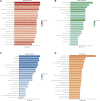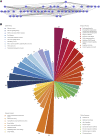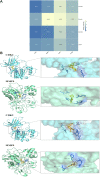The potential mechanism of Longsheyangquan Decoction on the treatment of bladder cancer: Systemic network pharmacology and molecular docking
- PMID: 35910372
- PMCID: PMC9330057
- DOI: 10.3389/fphar.2022.932039
The potential mechanism of Longsheyangquan Decoction on the treatment of bladder cancer: Systemic network pharmacology and molecular docking
Abstract
Our goal was to explore the bioactive constituents of Longsheyangquan (LSYQ) Decoction and elucidate its mechanisms on the treatment of bladder cancer (BCa). A total of 38 compounds were selected based on their pharmacokinetic properties in three large traditional Chinese medicine (TCM) databases. 654 putative targets of LSYQ Decoction were predicted using a structure-based, reverse-docking algorithm online, of which 343 overlapped with BCa-related protein-coding genes. The protein-protein interaction (PPI) network was constructed to perform module analysis for further Gene Ontology (GO) annotations and Kyoto Encyclopedia Genes and Genomes (KEGG) pathway enrichment analysis, which identified CDK2, EGFR, MMP9 and PTGS2 as hub targets. The TCM-compound-target network and compound-target-pathway network together revealed that quercetin, diosmetin, enhydrin and luteolin were the main components of LSYQ Decoction. Finally, molecular docking showed the affinity between the key compounds and the hub target proteins to verify the accuracy of drug target prediction in the first place. The present study deciphered the core components and targets of LSYQ Decoction on the treatment of BCa in a comprehensive systemic pharmacological manner.
Keywords: Longsheyangquan Decoction; bladder cancer; molecular docking; network pharmacology; target; traditional Chinese medicine.
Copyright © 2022 Cheng, Ye, Xu, Liang, Zhang, Chen, Dai, Ou, Mou, Li, Chen, Zhou, Zou, Mao and Jiang.
Conflict of interest statement
The authors declare that the research was conducted in the absence of any commercial or financial relationships that could be construed as a potential conflict of interest.
Figures








Similar articles
-
Mechanisms of Xiaozheng decoction for anti-bladder cancer effects via affecting the GSK3β/β-catenin signaling pathways: a network pharmacology-directed experimental investigation.Chin Med. 2023 Aug 22;18(1):104. doi: 10.1186/s13020-023-00818-5. Chin Med. 2023. PMID: 37608369 Free PMC article.
-
Investigating the active components of Huatan Tongjing decoction for the treatment of polycystic ovary syndrome via network pharmacology.Chem Biol Drug Des. 2022 Oct;100(4):515-524. doi: 10.1111/cbdd.14117. Epub 2022 Aug 2. Chem Biol Drug Des. 2022. PMID: 35822313
-
[Mechanism of Danggui Sini Decoction in treatment of primary dysmenorrhea based on network pharmacology and molecular docking].Zhongguo Zhong Yao Za Zhi. 2021 Feb;46(4):855-864. doi: 10.19540/j.cnki.cjcmm.20201104.401. Zhongguo Zhong Yao Za Zhi. 2021. PMID: 33645090 Chinese.
-
Exploration of the mechanism of Zisheng Shenqi decoction against gout arthritis using network pharmacology.Comput Biol Chem. 2021 Feb;90:107358. doi: 10.1016/j.compbiolchem.2020.107358. Epub 2020 Aug 8. Comput Biol Chem. 2021. PMID: 33243703 Review.
-
Network pharmacology prediction and molecular docking-based strategy to explore the potential mechanism of Huanglian Jiedu Decoction against sepsis.Comput Biol Med. 2022 May;144:105389. doi: 10.1016/j.compbiomed.2022.105389. Epub 2022 Mar 9. Comput Biol Med. 2022. PMID: 35303581 Review.
Cited by
-
Network Pharmacology Combined with Bioinformatics Analysis to Texplore the Potential Mechanism of Phellodendri Chinensis Cortex Against Bladder Cancer.Cell Biochem Biophys. 2024 Dec;82(4):3317-3331. doi: 10.1007/s12013-024-01414-6. Epub 2024 Jul 18. Cell Biochem Biophys. 2024. PMID: 39023680
-
Dujieqing decoction suppresses multiple myeloma growth by inhibiting the Wnt/β-catenin pathway.J Tradit Chin Med. 2025 Aug;45(4):720-729. doi: 10.19852/j.cnki.jtcm.2025.04.002. J Tradit Chin Med. 2025. PMID: 40810217 Free PMC article.
-
Mechanisms of Xiaozheng decoction for anti-bladder cancer effects via affecting the GSK3β/β-catenin signaling pathways: a network pharmacology-directed experimental investigation.Chin Med. 2023 Aug 22;18(1):104. doi: 10.1186/s13020-023-00818-5. Chin Med. 2023. PMID: 37608369 Free PMC article.
-
Study on the Mechanism of Yadanzi Oil in Treating Lung Cancer Based on Network Pharmacology and Molecular Docking Technology.ACS Omega. 2024 Apr 19;9(17):19117-19126. doi: 10.1021/acsomega.3c10105. eCollection 2024 Apr 30. ACS Omega. 2024. PMID: 38708221 Free PMC article.
-
The Related Mechanisms Predicted through Network-Based Pharmacological Analysis and the Anti-Inflammatory Effects of Fraxinus rhynchophylla Hance Bark on Contact Dermatitis in Mice.Int J Mol Sci. 2023 Mar 23;24(7):6091. doi: 10.3390/ijms24076091. Int J Mol Sci. 2023. PMID: 37047066 Free PMC article.
References
-
- Burdett S., Fisher D. J., Vale C. L., Sternberg C. N., Clarke N. W., Parmar M. K. B., et al. (2022). Adjuvant chemotherapy for muscle-invasive bladder cancer: A systematic review and meta-analysis of individual participant data from randomised controlled trials. Eur. Urol. 81, 50–61. 10.1016/j.eururo.2021.09.028 - DOI - PMC - PubMed
LinkOut - more resources
Full Text Sources
Research Materials
Miscellaneous

